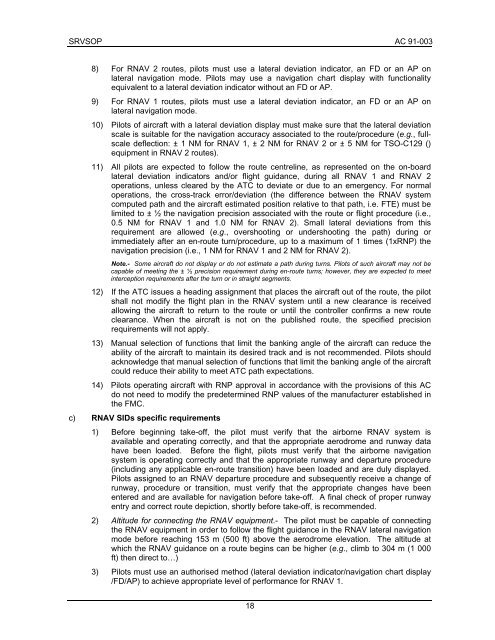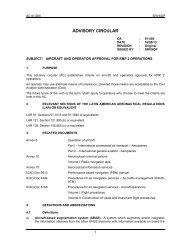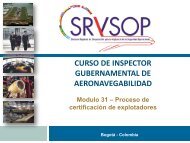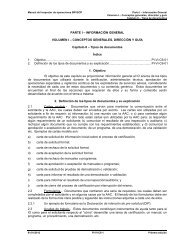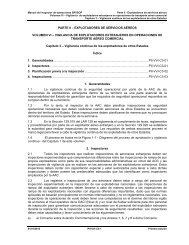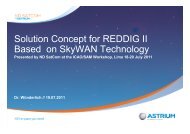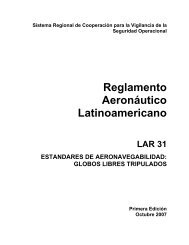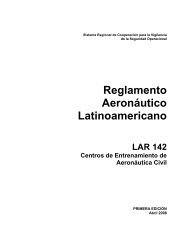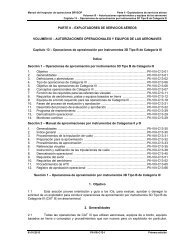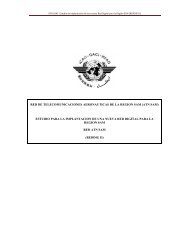ac 91-003 srvsop - ICAO
ac 91-003 srvsop - ICAO
ac 91-003 srvsop - ICAO
Create successful ePaper yourself
Turn your PDF publications into a flip-book with our unique Google optimized e-Paper software.
SRVSOP AC <strong>91</strong>-<strong>003</strong><br />
8) For RNAV 2 routes, pilots must use a lateral deviation indicator, an FD or an AP on<br />
lateral navigation mode. Pilots may use a navigation chart display with functionality<br />
equivalent to a lateral deviation indicator without an FD or AP.<br />
9) For RNAV 1 routes, pilots must use a lateral deviation indicator, an FD or an AP on<br />
lateral navigation mode.<br />
10) Pilots of aircraft with a lateral deviation display must make sure that the lateral deviation<br />
scale is suitable for the navigation <strong>ac</strong>cur<strong>ac</strong>y associated to the route/procedure (e.g., fullscale<br />
deflection: ± 1 NM for RNAV 1, ± 2 NM for RNAV 2 or ± 5 NM for TSO-C129 ()<br />
equipment in RNAV 2 routes).<br />
11) All pilots are expected to follow the route centreline, as represented on the on-board<br />
lateral deviation indicators and/or flight guidance, during all RNAV 1 and RNAV 2<br />
operations, unless cleared by the ATC to deviate or due to an emergency. For normal<br />
operations, the cross-tr<strong>ac</strong>k error/deviation (the difference between the RNAV system<br />
computed path and the aircraft estimated position relative to that path, i.e. FTE) must be<br />
limited to ± ½ the navigation precision associated with the route or flight procedure (i.e.,<br />
0.5 NM for RNAV 1 and 1.0 NM for RNAV 2). Small lateral deviations from this<br />
requirement are allowed (e.g., overshooting or undershooting the path) during or<br />
immediately after an en-route turn/procedure, up to a maximum of 1 times (1xRNP) the<br />
navigation precision (i.e., 1 NM for RNAV 1 and 2 NM for RNAV 2).<br />
Note.- Some aircraft do not display or do not estimate a path during turns. Pilots of such aircraft may not be<br />
capable of meeting the ± ½ precision requirement during en-route turns; however, they are expected to meet<br />
interception requirements after the turn or in straight segments.<br />
12) If the ATC issues a heading assignment that pl<strong>ac</strong>es the aircraft out of the route, the pilot<br />
shall not modify the flight plan in the RNAV system until a new clearance is received<br />
allowing the aircraft to return to the route or until the controller confirms a new route<br />
clearance. When the aircraft is not on the published route, the specified precision<br />
requirements will not apply.<br />
13) Manual selection of functions that limit the banking angle of the aircraft can reduce the<br />
ability of the aircraft to maintain its desired tr<strong>ac</strong>k and is not recommended. Pilots should<br />
<strong>ac</strong>knowledge that manual selection of functions that limit the banking angle of the aircraft<br />
could reduce their ability to meet ATC path expectations.<br />
14) Pilots operating aircraft with RNP approval in <strong>ac</strong>cordance with the provisions of this AC<br />
do not need to modify the predetermined RNP values of the manuf<strong>ac</strong>turer established in<br />
the FMC.<br />
c) RNAV SIDs specific requirements<br />
1) Before beginning take-off, the pilot must verify that the airborne RNAV system is<br />
available and operating correctly, and that the appropriate aerodrome and runway data<br />
have been loaded. Before the flight, pilots must verify that the airborne navigation<br />
system is operating correctly and that the appropriate runway and departure procedure<br />
(including any applicable en-route transition) have been loaded and are duly displayed.<br />
Pilots assigned to an RNAV departure procedure and subsequently receive a change of<br />
runway, procedure or transition, must verify that the appropriate changes have been<br />
entered and are available for navigation before take-off. A final check of proper runway<br />
entry and correct route depiction, shortly before take-off, is recommended.<br />
2) Altitude for connecting the RNAV equipment.- The pilot must be capable of connecting<br />
the RNAV equipment in order to follow the flight guidance in the RNAV lateral navigation<br />
mode before re<strong>ac</strong>hing 153 m (500 ft) above the aerodrome elevation. The altitude at<br />
which the RNAV guidance on a route begins can be higher (e.g., climb to 304 m (1 000<br />
ft) then direct to…)<br />
3) Pilots must use an authorised method (lateral deviation indicator/navigation chart display<br />
/FD/AP) to <strong>ac</strong>hieve appropriate level of performance for RNAV 1.<br />
18


